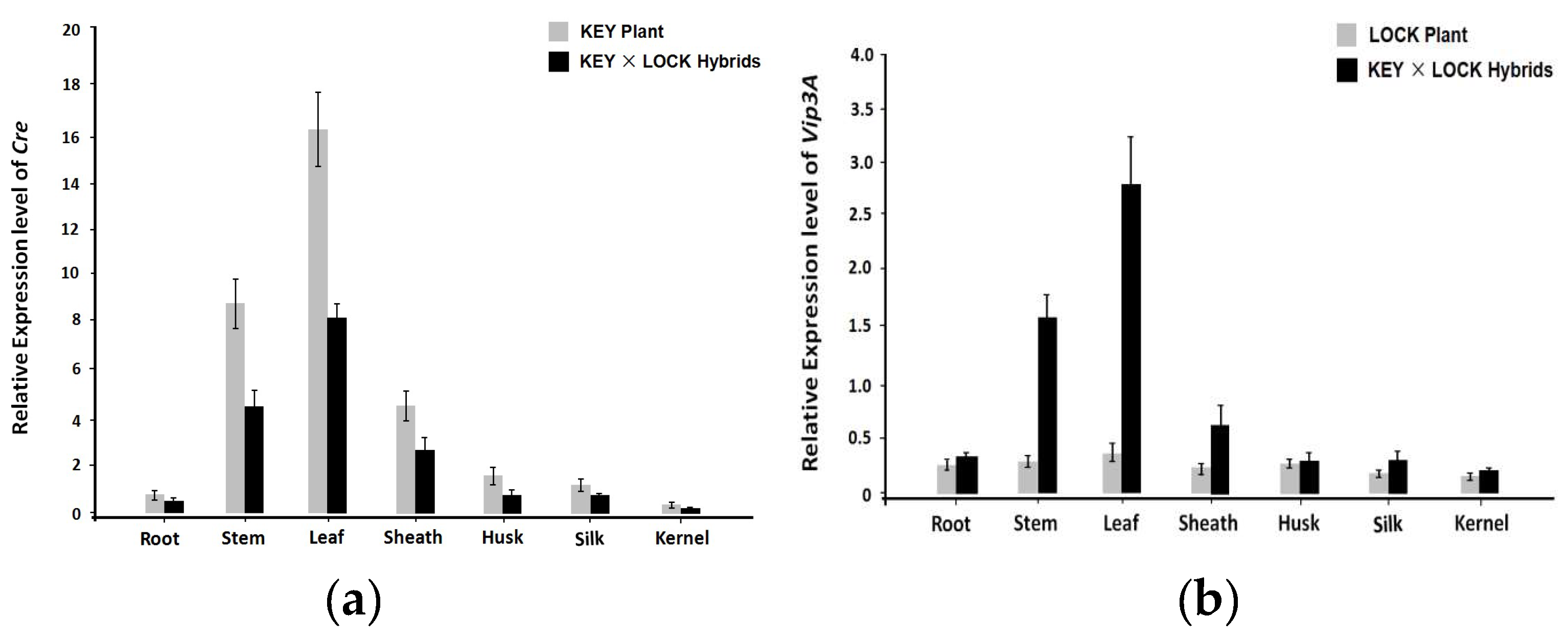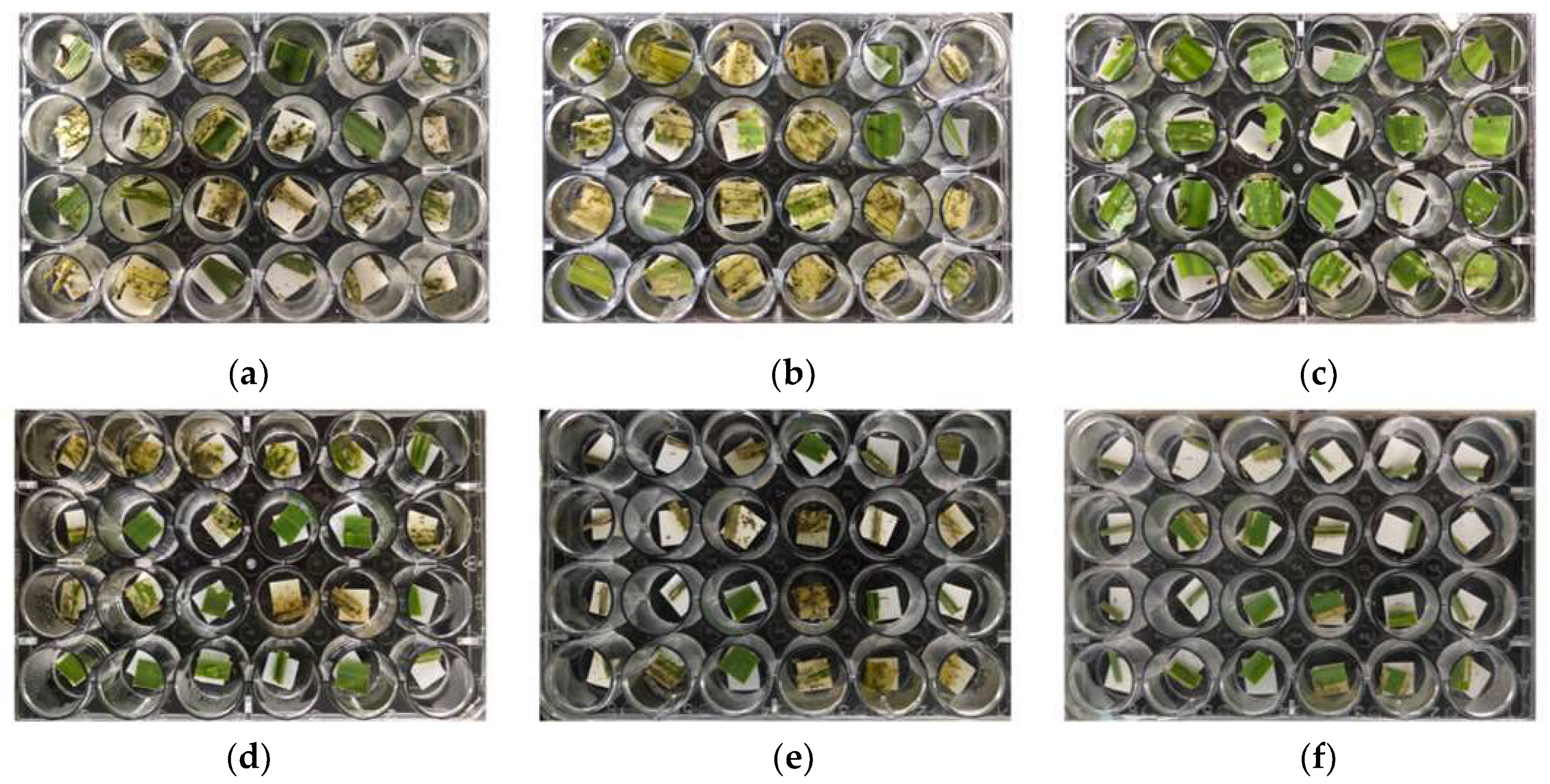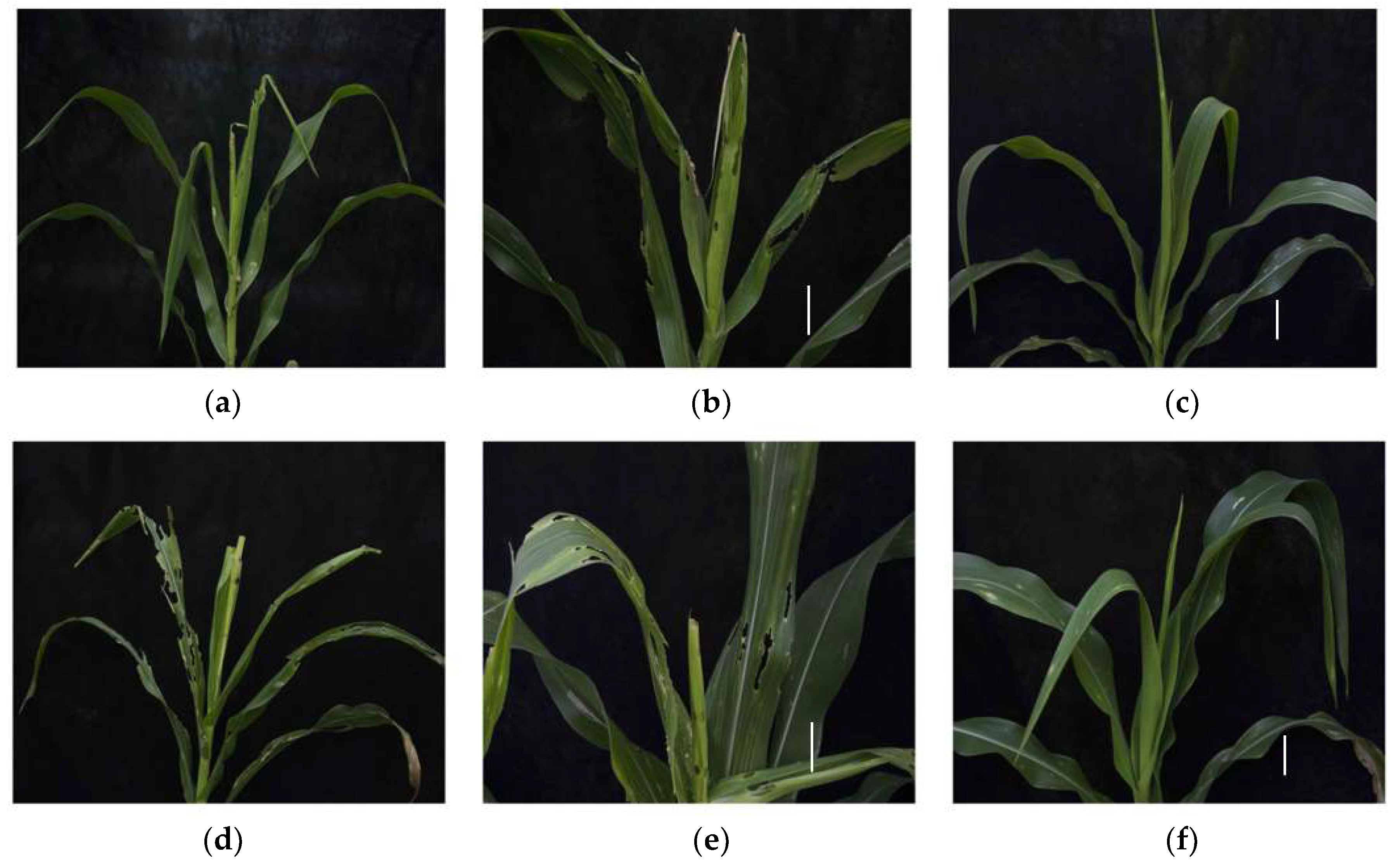Submitted:
25 August 2023
Posted:
28 August 2023
You are already at the latest version
Abstract
Keywords:
1. Introduction
2. Materials and Methods
2.1. Construction of fusion gene cassette
2.2. Plant material and transformation
2.3. Tissue expression in transgenic plants
2.4. Concentration of the Vip3A protein
2.5. Bioassay in laboratory
2.6. Field tests for insect resistance
2.7. Statistical analyses
3. Results
3.1. Fusion gene cassette and plant transformation
3.2. Tissue-specific expression of transgenes
3.3. The concentration of the insecticidal protein
3.4. The efficiency of insect resistance in transgenic maize
4. Discussion
5. Conclusions
Supplementary Materials
Author Contributions
Funding
Data Availability Statement
Acknowledgments
Conflicts of Interest
References
- Ahmad, M.; Ali, Q.; Hafeez, M.; Malik, A. Improvement for biotic and abiotic stress tolerance in crop plants. Biol. Clin. Sci. Res. J. 2021, 2021, e004. [Google Scholar] [CrossRef]
- Huang, F. Resistance of the fall armyworm, Spodoptera frugiperda, totransgenic Bacillus thuringiensis Cry1F corn in the Americas: lessons and implications for Bt corn IRM in China. Insect Sci. 2021, 28, 574–589. [Google Scholar] [CrossRef]
- Yang. X.; Zhao, S.; Liu, B.; Gao, Y.; Hu, C.; Li, W.; Yang, Y.; Li, G.; Wang, L.; Yang, X.; et al. Bt maize can provide non-chemical pest control and enhance food safety in China. Plant Biotechnol. J. 2023, 21, 391–404. [Google Scholar] [CrossRef] [PubMed]
- Gutiérrez-Moreno, R.; Mota-Sanchez, D.; Blanco, C.A.; Whalon, M.E.; Terán-Santofimio, H.; Rodriguez-Maciel, J.C.; DiFonzo, C. Field-evolved resistance of the fall armyworm (Lepidoptera: Noctuidae) to synthetic insecticides in Puerto Rico and Mexico. J. Econ. Entomol 2019, 112, 792–802. [Google Scholar] [CrossRef] [PubMed]
- Pardo-López, L.; Soberón, M.; Bravo, A. Bacillus thuringiensis insecticidal three-domain Cry toxins: mode of action, insect resistance and consequences for crop protection. FEMS Microbiol. Rev. 2013, 373, 22. [Google Scholar]
- Rostoks, N.; Grantiņa-Ieviņa, L.; Ieviņa, B.; Evelone, V.; Valciņa, O.; Aleksejeva, I. Genetically modified seeds and plant propagating material in Europe: potential routes of entrance and current status. Heliyon 2019, 5, e01242. [Google Scholar] [CrossRef]
- Li, G.P.; Feng, H.Q.; Ji, T.J.; Huang, J.R.; Tian, C.H. What type of Bt corn is suitable for a region with diverse lepidopteran pests: A laboratory evaluation. GM Crops Food 2021, 12, 115–124. [Google Scholar] [CrossRef]
- Romeis, J.; Naranjo, S.E.; Meissle, M.; Shelton, A.M. Genetically engineered crops help support conservation biological control. Biol. Control 2019, 130, 136–154. [Google Scholar] [CrossRef]
- Yang, F.; González, J.C.S.; Williams, J.; Cook, D.C.; Gilreath, R.T. ; Kerns, D,L, Occurrence and ear damage of Helicoverpa zea on transgenic Bacillus thuringiensis maize in the field in Texas, US and its susceptibility to Vip3A protein. Toxins 2019, 11, 102. [Google Scholar] [CrossRef]
- He, K.; Wang, Z.; Wen, L.; Bai, S.; Ma, X.; Yao, Z. Determination of baseline susceptibility to Cry1Ab protein for Asian corn borer. J. Appl. Entomol. 2005, 129, 407–412. [Google Scholar] [CrossRef]
- Perry, E.D.; Ciliberto, F.; Hennessy, D.A.; Moschini, G. Genetically engineered crops and pesticide use in U.S. maize and soybeans. Sci. Adv. 2016, 2, e1600850. [Google Scholar] [CrossRef] [PubMed]
- Alderborn, A.; Sundström, J.; Soeria-Atmadja, D.; Sandberg, M.; Andersson, H.C. Hammerling U, Genetically modified plants for non-food or non-feed purposes: Straightforward screening for their appearance in food and feed. Food Chem. Toxicol. 2010, 48, 453–464. [Google Scholar] [CrossRef] [PubMed]
- Li, Y.H.; Hallerman, E.M.; Peng, Y.F. How can China prepare for the domestic cultivation of Bt maize? Trends Food Sci. Technol. 2018, 73, 87–88. [Google Scholar] [CrossRef]
- Domingo. JL.; Bordonaba, J.G. A literature review on the safety assessment of genetically modified plants. Environ. Int. 2011, 37, 734–742. [Google Scholar] [CrossRef]
- Gilbertson. L. Cre-lox recombination: Cre-ative tools for plant biotechnology. Trends Biotechnol. 2003, 21, 550–555. [Google Scholar] [CrossRef]
- Kamatham, S.; Munagapati, S.; Manikanta, K.N.; Vulchi, R.; Chadipiralla, K.; Indla, S.H.; Allam, U.S. Recent advances in engineering crop plants for resistance to insect pests. Egypt. J. Biol. Pest Control. 2021, 31, 120. [Google Scholar] [CrossRef]
- Bai, X.Q.; Wang, Q.Y.; Chu, C.C. Excision of a selective marker in transgenic rice using a novel Cre/loxP system controlled by a floral specific promoter. Transgenic Res. 2008, 17, 1035–1043. [Google Scholar] [CrossRef]
- Chen, Y.; Rice, P.A. New insight into site-specific recombination from Flp recombinase-DNA structures. Annu. Rev. Biophys. Biomol. Struct. 2003, 32, 135–159. [Google Scholar] [CrossRef]
- Li, Z.S.; Xing, A.Q.; Moon, B.P.; Burgoyne, S.A.; Guida, A.D.; Liang, H.L.; Lee, C.; Caster, C.; Barton, J.; Klein, T.; et al. A Cre/loxP-mediated self-activating gene excision system to produce marker gene free transgenic soybean plants. Plant Mol. Biol, 2007, 65, 329–341. [Google Scholar] [CrossRef]
- Maeser, S.; Kahmann, R. The Gin recombinase of phage Mu can catalyse site-specific recombination in plant protoplasts. Mol. Gen. Genet. 1991, 230, 170–176. [Google Scholar] [CrossRef]
- Mlynarova, L.; Conner, A.J.; Nap, J.P. Directed microspore-specific recombination of transgenic alleles to prevent pollen-mediated transmission of transgenes. Plant Biotechnol. J. 2006, 4, 445–452. [Google Scholar] [CrossRef] [PubMed]
- Siebert, R.; Puchta, H. Efficient repair of genomic double-strand breaks by homologous recombination between directly repeated sequences in the plant genome. Plant Cell 2002, 14, 1121–1131. [Google Scholar] [CrossRef]
- Pradhan, S.; Chakraborty, A.; Sikdar, N.; Chakraborty, S.; Bhattacharyya, J.; Mitra, J.; Manna, A.; Gupta, S.D.; Sen, S.K. Marker-free transgenic rice expressing the vegetative insecticidal protein (Vip) of Bacillus thuringiensis shows broad insecticidal properties. Planta 2016, 244, 789–804. [Google Scholar] [CrossRef] [PubMed]
- Tuteja, N.; Verma, S.; Sahoo, R.K.; Raveendar, S.; Reddy, B.L. Recent advances in development of marker-free transgenic plants: regulation and biosafety concern. J. Biosci. 2012, 37, 167–97. [Google Scholar] [CrossRef]
- Hoa, T.T.C.; Huq, E.; Vincent, J.R.; Hodges, H.K.; Bong, B.B.; Hodges, T.K. Cre/lox site-specific recombination controls the excision of a transgene from the rice genome. Theor. Appl. Genet. 2002, 104, 518–525. [Google Scholar] [CrossRef] [PubMed]
- Chen, H.; Luo, J.; Zheng, P.; Zhang, X.; Zhang, C.; Li, X.; Wang, M.; Huang, Y.; Liu, X.; Jan, M.; et al. Application of Cre-lox gene switch to limit the Cry expression in rice green tissues. Sci. Rep. 2017, 7, 14505. [Google Scholar] [CrossRef]
- Boszorádová, E.; Matušíková, I.; Libantová, J.; Zimová, M.; Moravčíková, J. Cre-mediated marker gene removal for production of biosafe commercial oilseed rape. Acta Physiol. Plant 2019, 41, 73. [Google Scholar] [CrossRef]
- Luo, K.; Duan, H.; Zhao, D.; Zheng, X.; Deng, W.; Chen, Y.; Stewart Jr, C. N.; McAvoy, R.; Jiang, X.; Wu, Y.; et al. ‘GM-gene-deletor’: fused loxP-FRT recognition sequences dramatically improve the efficiency of FLP or CRE recombinase on transgene excision from pollen and seed of tobacco plants. Plant Biotechnol. J. 2007, 5, 263–274. [Google Scholar] [CrossRef]
- Moravcikova, J.; Vaculkova, E.; Bauer, M.; Libantova, J. Feasibility of the seed specific cruciferin C promoter in the self excision Cre/loxP strategy focused on generation of marker-free transgenic plants. Theor. Appl. Genet. 2008, 117, 1325–1334. [Google Scholar] [CrossRef]
- Schaffner, A.R.; Sheen, J. Maize rbcS promoter activity depends on sequence elements not found in dicot rbcS promoters. Plant Cell 1991, 3, 997–1012. [Google Scholar]
- Frame, B.R.; Shou, H.; Chikwamba, R.K.; Zhang, Z.; Xiang, C.; Fonger, T.M.; Pegg, S.E.K.; Li, B.; Nettleton, D.S.; Pei, D.; et al. Agrobacterium tumefaciens-mediated transformation of maize embryos using a standard binary vector system. Plant Physiol, 2002, 129, 13–22. [Google Scholar] [CrossRef] [PubMed]
- Abbott, W.S. A method of computing the effectiveness of an insecticide. J. Econ. Entomol. 1925, 18, 265–267. [Google Scholar] [CrossRef]
- Toepfer, S.; Fallet, P.; Kajuga, J.; Bazagwira, D.; Mukundwa, I.P.; Szalai, M.; Turlings, T.C. Streamlining leaf damage rating scales for the fall armyworm on maize. J. Pest Sci. 2021, 94, 1075–1089. [Google Scholar] [CrossRef]
- Xiao, Z.; Kerr, W.A. Biotechnology in China-regulation, investment, and delayed commercialization. GM Crops Food 2022, 13, 86–96. [Google Scholar] [CrossRef] [PubMed]
- Cai, M.; Wei, J.; Li, X.; Xu, C.; Wang, S. A rice promoter containing both novel positive and negative cis-elements for regulation of green tissuespecific gene expression in transgenic plants. Plant Biotechnol. J. 2007, 5, 664–674. [Google Scholar] [CrossRef] [PubMed]
- Hamzeh, S.; Motallebi, M.; Zamani, M.R. Efficient seed-specifically regulated autoexcision of marker gene (nptII) with inducible expression of interest gene in transgenic Nicotiana tabacum. Turk. J. Biol. 2016, 40, 1–11. [Google Scholar] [CrossRef]
- Sugita, K.; Kasahara, T.; Matsunaga, E.; Ebinuma, H. A transformation vector for the production of marker-free transgenic plants containing a single copy transgene at high frequency. Plant J. 2000, 22, 461–469. [Google Scholar] [CrossRef]
- Ye, R.; Huang, H.; Yang, Z.; Chen, T.; Lin, Y. Development of insect resistant transgenic rice with Cry1C-free endosperm. Pest Manag. Sci. 2009, 65, 1015–1020. [Google Scholar] [CrossRef]
- Koziel, M.G.; Beland, G.L.; Bowman, C.; Carozzi, N.B.; Crenshaw, R.; Crossland, L.; Dawson, J.; Desai, N.; Hill, M.; Kadwell, S.; et al. Field performance of elite transgenic maize plants expressing an insecticidal protein derived from bacillus thuringiensis. Nat. Biotechnol. 1993, 11, 194–200. [Google Scholar] [CrossRef]
- Wang, Q.; Zhu, Y.; Sun, L.; Li, L.; Jin, S.; Zhang, X. Transgenic Bt cotton driven by the green tissue-specific promoter shows strong toxicity to lepidopteran pests and lower Bt toxin accumulation in seeds. Sci. China Life Sci. 2016, 59, 172–182. [Google Scholar] [CrossRef]
- Ye, R.; Zhou, F.; Lin, Y. Two novel positive cis-regulatory elements involved in green tissue-specific promoter activity in rice (Oryza sativa L ssp.). Plant Cell Rep. 2012, 31, 1159–1172. [Google Scholar] [CrossRef] [PubMed]




| Plant material | Root (ng/g) |
Stem (ng/g) |
Leaf (ng/g) |
Sheath (ng/g) |
Husk (ng/g) |
Silk (ng/g) |
Kernel (ng/g) |
|---|---|---|---|---|---|---|---|
| LOCK | 0.73 ± 0.12 | 0.51 ± 0.07 | 0.43 ± 0.09 | 0.74 ± 0.13 | 0.62 ± 0.07 | 0.68 ± 0.11 | 0.59 ± 0.08 |
| KEY × LOCK | 0.68 ± 0.23 | 6.13 ± 0.41** | 9.59 ± 0.38** | 1.08 ± 0.29 | 0.91 ± 0.35 | 0.74 ± 0.15 | 0.71 ± 0.12 |
| Plant material | Larval mortality (%) | Plant leaf damage scale | ||
|---|---|---|---|---|
| O. furnacalis | O. furnacalis | O. furnacalis | O. furnacalis | |
| KN5585 | 8.3 ± 0.9b | 8.7 ± 0.7b | 7.5 ± 0.4b | 8.1 ± 0.5b |
| LOCK | 10.6 ± 1.4b | 9.2 ± 1.2b | 7.7 ± 0.5b | 7.9 ± 0.3b |
| KEY × LOCK | 81.2 ± 3.7a | 73.6 ± 2.9a | 2.4 ± 0.1a | 1.6 ± 0.1a |
Disclaimer/Publisher’s Note: The statements, opinions and data contained in all publications are solely those of the individual author(s) and contributor(s) and not of MDPI and/or the editor(s). MDPI and/or the editor(s) disclaim responsibility for any injury to people or property resulting from any ideas, methods, instructions or products referred to in the content. |
© 2023 by the authors. Licensee MDPI, Basel, Switzerland. This article is an open access article distributed under the terms and conditions of the Creative Commons Attribution (CC BY) license (https://creativecommons.org/licenses/by/4.0/).





